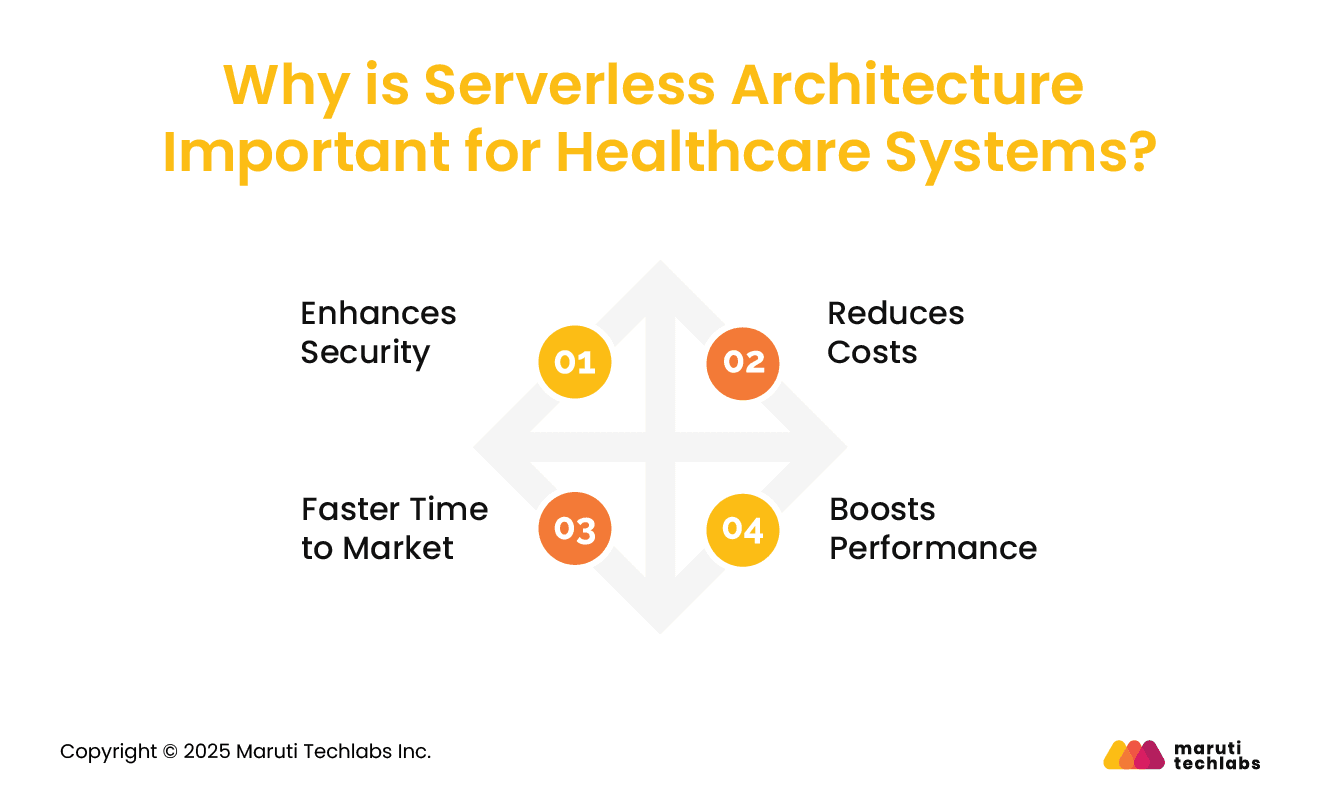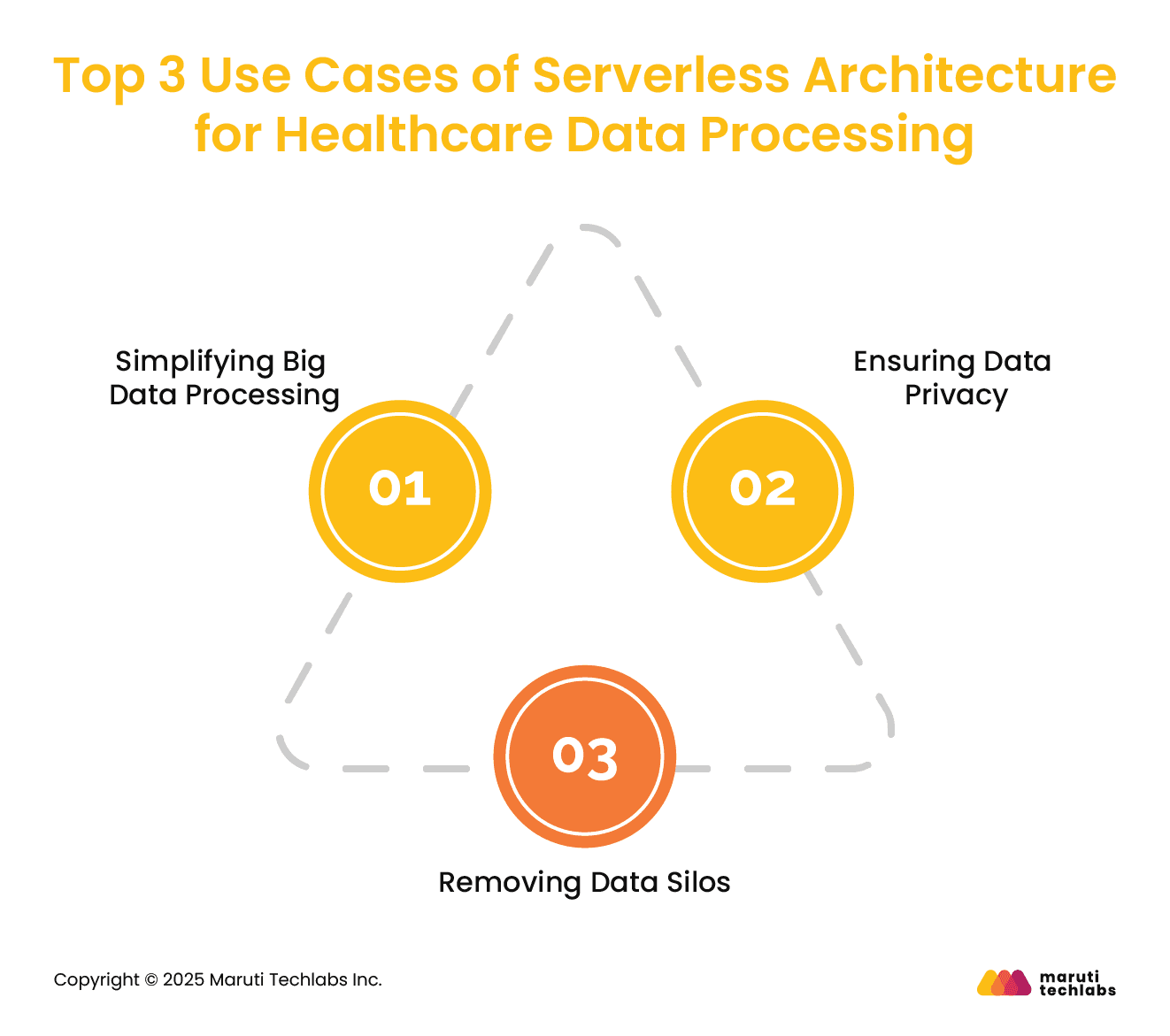

Transforming Healthcare With Serverless: New Era In Data Processing






One of the key contributors to consumer marketing is Data Mining. It helps learn a lot about customers' habits with every purchase. The healthcare industry is finally making the best use of this technology.
An industry experiencing an explosion of data is experiencing a high demand for efficient IT systems. Therefore, it requires scalable, cost-effective, and compliant data processing to manage growing data volumes, ensure patient privacy, meet regulatory standards, and support real-time insights for improved clinical and operational outcomes.
A report from RBC Capital Markets states that today, almost 30% of the world’s data volume is generated by the healthcare industry.
It’s evident that managing such high amounts of data on a regular basis while ensuring security and abiding with regulatory requirements is a tremendous challenge.
Especially having an ever-scalable IT infrastructure that can accommodate such data volumes.
Here comes serverless architecture to your rescue. Serverless architecture supports developers to create and execute applications while not having to worry about the underlying infrastructure. Concerning the healthcare industry, it contributes by helping deploy isolated apps, handling sensitive patient data, managing electronic health records (EHRs), and more.
In this blog, we discuss the importance of serverless architecture in healthcare, essential AWS services that can help, and its top use cases.
Implementing serverless architecture is becoming the new norm for healthcare platforms. Here are four reasons why.
Serverless architecture enhances security for cloud functions. One can divide each function into smaller functions and observe potential security threats. These functions don’t consume any memory as they die after use.
It mitigates the risks of long-term attacks. The development team can also participate in this activity, setting limitations for its role and implementing the best security practices and security features for each function.
Cloud providers like Azure, AWS, and Google are HIPAA compliant and offer hardware and software updates, security, maintenance, and administration assistance. They prioritize implementing the best security practices to prevent data leaks and cyber-attacks.
The pay-per-use pricing model offered with serverless architecture helps reduce costs. It allows you to pay for only what’s allocated and used. The charges are dependent on the functions executed and the workload utilized.
In addition, the cloud providers also perform maintenance and troubleshooting, freeing up more time for other essential tasks.

Unlike operational tasks, serverless architecture allows you to focus on application improvements, user satisfaction, and experiments. Providers take care of other administrative tasks to facilitate quicker time to market.
Scalability is one of the biggest perks, allowing you to add and remove resources as needed. Your data is backed up across distributed servers, aiding the app's availability in case of a server failure. Whether you use an EHR or any IoT device, serverless is an apt solution for processing large volumes of health data.
Here is the list of 6 AWS services that are crucial for implementing a serverless architecture in healthcare.
It executes code by responding to file uploads, database updates, and API calls. It is an essential tool for managing workflows, real-time analytics, and processing patient data.
It allows you to build, deploy, and manage secure APIs, pivotal in operating electronic health records (EHR), patient management, and telemedicine.
It offers a performant, organized, and NoSQL database. It is a perfect tool for storing clinical data, transactional logs, and patient records.
It stores various types of data and offers unmatched scalability. It is best used for saving backup data, compliance records, and medical images.
It facilitates communication amongst microservices via messaging and notifications. SNS can be best utilized for appointment reminders, emergency notifications, and patient updates.
It ensures coordination amongst multiple AWS services by mapping cumbersome workflows. This tool offers maximum usability when working with multi-step processes like insurance claims management, lab results processing, and patient admission workflow.
Let’s observe three practical implications of serverless architecture for healthcare data processing.

Using a cloud-native service, AWS Elastic MapReduce (EMR), can simplify big data processing by handling underlying infrastructure. This allows users to focus more on data analytics.
It facilitates cost savings by offering resource scaling on-demand and supporting Spark, Hadoop, and Apache. In addition, EMR facilitates efficient data workflows by seamlessly integrating with other AWS services like Glue, S3, and Redshift.
It’s essential to protect patient-sensitive data in healthcare. AWS Lambda complies with HIPAA and offers many unique security features. One such example is its data encryption feature in transit and at rest.
One of the other essential aspects of data privacy is secure access controls. It’s enforced on individuals accessing patient data to protect sensitive information.
Data sharing is imperative in healthcare organizations. Therefore, data silos can become a huge hurdle. Using tools like AWS Lambda removes data silos, integrates distributed systems, and offers patient data access across the organization.
Lambda creates a centralized data repository by combining data from imaging systems, laboratory systems, and electronic health records (EHRs). It offers complete information about a patient’s health and treatment history. This integrated data also assists them with making informed decisions while reducing errors and inconsistencies.
Organizations handling protected health information (PHI) must comply with HIPAA. Non-compliance can have dire legal consequences and hefty fines. Serverless computing eliminates the hassle of running applications and services without worrying about infrastructure management, making it perfect for businesses that must comply with HIPAA.
Ensuring HIPAA compliance with serverless functions requires attention to many security layers. Leveraging services like Lambda can help with private and proper security groups. It also offers transport-level security as a functional URL with HTTPS.
Here are different areas where it offers assistance:
| Transport and Data Level Security |
|
| Access Control |
|
| Network Security |
|
| Audit Controls |
|
| Security Logging and Monitoring |
|
| Service Level Agreement |
|
| Disaster Recovery Mechanisms |
|
| Backup and Restores |
|
Using serverless platforms, including numerous functions, is a considerable achievement for organizations dealing with PHI. Non-eligible services can also be leveraged for processing metadata, transmission, and orchestrating storage.
Serverless architecture in healthcare has a promising future. It offers scalable, cost-effective, and secure solutions for data processing, patient engagement, and real-time analytics. By managing infrastructure, serverless enables faster deployment of HIPAA-compliant applications, telemedicine platforms, and AI-driven diagnostics.
It fosters enhanced interoperability and compliance by integrating secure APIs and robust cloud services. As privacy regulations evolve, serverless will continue to support innovation, offering specific access controls, event-driven workflows, and built-in fault tolerance. With the growing adoption of FHIR standards and real-time health data streams, serverless computing will be a key contributor to digital health ecosystems.
Serverless architecture in healthcare encourages a futuristic approach that enhances data processing and scalability, subsequently aiding operational efficiency. By leveraging serverless app development services, healthcare organizations can build agile, cost-effective solutions that automatically scale with demand. In addition, serverless offers robust security and access control, preventing unauthorized access to sensitive patient data.
If your healthcare firm still depends on on-premise infrastructure, it's time to prioritize reforming your healthcare data infrastructure. Partnering with experts in serverless app development services can help you transition smoothly, ensuring compliance, reducing overhead, and future-proofing your systems.
We implemented this for one of our clients, a US-based insurance firm. They faced high costs due to underutilized AWS resources and lack of visibility. Maruti Techlabs conducted a detailed assessment and implemented autoscaling, right-sizing, and cost-monitoring tools. As a result, the company reduced AWS costs by 45%, improved performance, and gained real-time insights into cloud usage for better decision-making.
Our years of experience and expertise with cloud consulting services can help your healthcare organization plan a seamless migration to serverless architecture. Connect with us today to learn how you can leverage the power of serverless computing and transform patient care.
Looking for cloud based solutions in Dallas? Our experts at Maruti Techlabs can help you design and implement secure, scalable, and cost-optimized serverless solutions tailored to your healthcare needs.
The best serverless architecture combines event-driven design with managed services like AWS Lambda, API Gateway, S3, DynamoDB, and Step Functions.
It emphasizes microservices, stateless functions, and specific IAM controls. This approach enhances scalability, fault tolerance, and cost-efficiency while reducing operational overhead, making it ideal for modern cloud-native applications.
Serverless data processing is a cloud-native approach that processes data using event-driven, on-demand compute services without managing servers.
Platforms like AWS Lambda, Azure Functions, or Google Cloud Functions automatically scale and execute code in response to data events, enabling efficient, cost-effective, and scalable processing pipelines for various workloads.
Yes, serverless can be secure for sensitive healthcare data if implemented with strong encryption, access controls, VPC isolation, and compliance with HIPAA standards using cloud provider security best practices.
Serverless architecture handles large healthcare datasets by leveraging scalable services like AWS Lambda with S3, Kinesis, and Step Functions for parallel, event-driven processing.
It breaks data into manageable chunks, processes them asynchronously, and scales automatically. Integration with data lakes and batch jobs ensures efficient handling of high-volume, sensitive healthcare information.
Common serverless use cases in healthcare include
It also enables scalable, low-latency, and HIPAA-compliant solutions with reduced infrastructure management.


